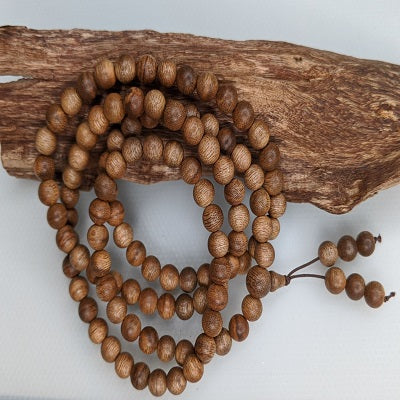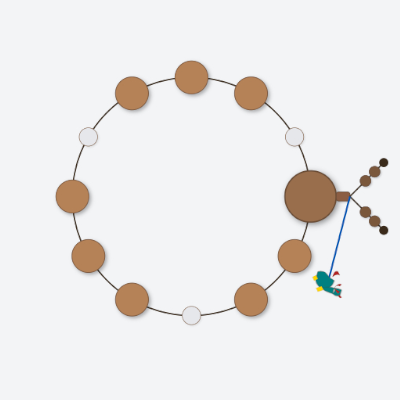Menu
-
-
F.A.Q
- How to identify genuine agarwood chip, natural or cultivated
- How to identify oil injection / absorption fake agarwood beads
- How to know if there are more than one oil in your oil
- How to make your wood bracelet or mala darker
- How to tell if an Agarwood bead sinks WITHOUT sinking it under water?
- How does back flow incense work and how do you burn it?
- Where to start if you don't know what agarwood is ?
- Why are you losing money if you buy seeds and plants?
- Which agarwood incense should I choose?
- Frequently Asked Questions
- Agarwood Related Articles
- Shipping
-
SHOP - Agarwood
-
SHOP - Other Fragrant Wood
-
SHOP - Incense Holder and Burner
-
- FREE Oud Oil guide
- Testimonials
- "Why did you buy this?"
- Contact us
- About Us
- +61430284329
- Login
-
English


The King was suffering from anxiety and the Buddha showed him a way to relieve it
March 24, 2020 7 min read
The anxious king
In the 7th Century BCE, King of Rajagaha (now is Rajg), Bimbisara had been suffering from anxiety. Traditional medicine was not very useful for him.
The King learnt that Buddha was at Gijjhakuta (Gṛdhrakūṭa) at that time. So he sent a messenger to ask for Buddha’s help (Kieschnick, John,2003)
After hearing the King's story, Buddha instructed him to
- make a 108 mala (japamala) from the seeds of aristaka plant
- Pass each beach of the mala through his finger when reciting Buddhist Scripture
When anxiety came, the king chanted the scripture with passing these mala beads through his finger. Over time, this action calmed his mind and relieved his stress.
Does it work?
For who is practising Pureland Buddhism, the practice of chanting Amitābha Buddha name is a daily joyful activity (click here to listen if you wanted to know how it sounds like).
The goal of chanting is to achieve "One stable heart without confusion" Practitioner (一心无乱"). I have witnessed it myself in several templates that many monks or Buddhist using a mala to chant.
Out of curiosity, I approached one of the members and asked for the experience. Fortunately, he was kind enough to talk to me.
The gentleman was at his 50. He had a wife and two children.
He wore a bodhi seed mala. And he told me that the mala certainly assisted him to stay awake when listening to some Buddhist discourse. It also helped him focus on chanting and counting the mantra.
He told me that repetition is essential. Sometimes, he forgot which page or session he was at. The mala helped him back on track.
After a while, he told me that his anger was under management. He could control himself much better. His anxiety would come and go, but at least he knew how to "face" it.
You may be saying. OK, it works for a Buddhist, but does it work for others?
I would like to share a personal story with you.
When I was around ten years old, I enrolled in martial art lessons.
In one of many lessons, there was a challenge that many students struggle with.

To break the 1cm- PVC breakable board with a straight punch.
In the beginning, I could not do it, and my knuckle was hurt.
So I started to condition my hand by pushing up, punching sandbag.
But no matter what I did, I could not punch through. The board did not break.
The feeling of being laughed at in front of the crowd deterred me to keep going (although no-one really laughed at me in the class, I felt it internally)
I was so scared every time the instructor called my name.
It became anxiety. I made many excuses not to come to class.
Fortunately, my instructor could see my problem. After a friendly chat, he told me two fundamental things to break the board.
- “First, when you punch, don’t just punch the board, go beyond this. Punch through it. Just like a pullet hit a paper and pass-through.”
- “For the next 14 days, every night, before you sleep and when you wake up, imagine your hand is like a bullet, fly through the paper, not just stop there. You need to keep telling yourself mentally that until it became part of you”.
Later on, I learnt this technique is called “Self-affirmation”. It became subconscious and drove my action.
My goal was so clear: To break that board in the next 14 days.
Practice makes perfect right. Not just mentally, but physically, I bought myself the board and practised it at home.
On the 7th day, my punch flew through the board, breaking it in half. I could not believe I did it.
You see, when the King was reciting or chanting the Buddhist Scripture, he was repeating Buddha’s teachings mentally. And when using the mala while chanting, he could focus more. Over time, this practice imprinted Buddha’s teaching into his memory. As a result, he felt better.
When I learnt about how the King did relieve this anxiety, I immediately recalled my martial art lesson.
The mala, in this case, was like “my breakable board” and the Buddha teaching was like “my coach teaching.
The key is repetition. Keep repeating something will make it second nature.
The king wanted to relieve his anxiety, so he chanted frequently.
Often he was side-tracked. So by using a 108 mala, he integrated his sensory with his mind. This practice will help him remember the mantra, to affirm his belief and to speed up his goal: relieve from anxiety.
A side note: mala is also known as japamala. Japa is the process of mentally repeating a mantra in Sanskrit.
Using a mala when chanting will improve the practitioner concentration (Yoga International)
You don't have to chant a mantra. Just simply repeat a positive self-talk.
Please note, it works for non-religious people too. I have a friend who joined a Yoga Club in Brisbane. Her coach told her to pass a mala through a finger and repeat a positive self-talk phase.
"I am stronger than this, and I will do whatever it takes to overcome this obstacle".
Does it work for her?
She told me after repeating positive self-talk long enough. It became a reality. She has become a better version of herself. A small but consistent daily improvement
But does it mean it works for others?
The key is repetitive action overtime.
It works for children.
Children with negative competence beliefs often achieve below their potential in school (Thomaes et_al 2019).
To change that belief over time, children are asked to repeat the following:
"[I WILL DO MY VERY BEST!]/[I AM VERY GOOD AT THIS!], in the effort and ability self-talk Positive Self-Talk conditions, respectively
They were then instructed to “keep thinking about the second half of the test (say, for about 30 s) and quietly repeat [I WILL DO MY VERY BEST!]/[I AM VERY GOOD AT THIS!].
Next, children were requested to write down the phrase they had just said to themselves, and they were encouraged to quietly repeat the phrase while working on the second part of the test, “especially if you find a problem challenging.”
Engaging in effort self-talk helped these children sustain their level of performance, and prevented deteriorating it that otherwise occurred
You see the self-talk is like chanting or reciting.
And when they write it down, it amplifies the belief stronger.
The action of writing it down is similar to passing the mala beads through one hand.
If their parents focused on their children's positive side, encouraging them frequently to do what they are good at, their confidence and happiness would improve. When this happened their performance would improve (GSE Harvard University)
The International Journal of Pharmaceutical Sciences and Research (Roy at al, 2016) showed the benefit of chanting “Om Namah Shivaya Mantra.”
“. After the practice sessions, participants chanted Om Namah Shivaya for 108 times by using japamala with 108 beads at 6;30 in the morning for 40 days under supervision of yoga teacher….Our study agrees with earlier reports as we have observed a significant decrease in the depression, anxiety and stress levels followed by chanting and significant improvement in MMSE scores. Though blood pressure decreased followed by chanting, it was not statistically significant.”
It works for people with high blood pressure.
You may be interested as it also works from someone with high blood pressure.
In 2018 a study of the National Journal of Physiology, Pharmacy and Pharmacology (Arora et al. 2018) showed the “Immediate benefits of “Om” chanting on blood pressure and pulse rate in uncomplicated moderate hypertensive subjects.”
After just 5 minutes of Om chanting, there was a significant reduction in blood pressure. And six beats of pulse rate was observed immediately.
It works for ordinary folk like you and me.
For some of us, daydreaming frequently happens after a short period of time. As a result, we lost concentration when meditating; some even go to sleep.
Using a 108 mala will help you to stay focused when meditating. By counting the beads, you integrate your sense of touch with your mantra or simply, your positive self-talk. You feel it in your hand; you can even listen to the sound when these beads are passing through your fingers. It enhances your experiences of chanting your positive "self-image."
Through repetition, the next time you practise, your focus will improve as well as your awareness.
Any mala or japamala will work
There are different materials to make mala. For example, gemstones, amber, plastic, wood and precious metals.
Which one should you choose?
A japamala is a japamala. It will help you with your spiritual practice. In my opinion, they will all work because they act like a "visual aid". When you touch the mala, it "reminded" you the message you have been practising.
So if you kept telling yourself you were strong while using the mala, you would be "triggered" when touching the mala.
About the material of making the mala, It is entirely your choice.
However, as we are agarwood growers, we would like to talk a bit about the agarwood mala because it has some unique features listed below.
More about the agarwood mala (or japamala)
When you look for mala to wear, pray, or chant, it makes sense to look for something unique and meaningful. So you may find the below value interested you.
Spiritual Value
- Agarwood appeared in the Holy Bible, the Buddhist Scriptures, the Hindu text, the Islamic Q’ran.
- Many Priests or Feng Shui Masters recommended agarwood bracelets or mala to their disciples, and practitioners to wear. They said it would help the wearer gain peace and calm.
- In the form of chips (agarwood chips), it was appreciated by many people from different background with or without religions. The sense when heated is known as "The Scent from Heaven."
Fashionable Value
Besides the spiritual value, below are additional
- Skin-friendly: Agarwood mala is essential made from wood beads with resin. And wood is organic and non-irritant. It means you are unlikely to get an adverse reaction from this agarwood mala
- Comfortable: It is light-weight, around 10g to 22g.
- Last longer: your body sweat can tarnish metal jewellery. However, with agarwood, it is the opposite. Your sweat will add more texture to these beads. Over time, it will become glossier. The good news is: you can polish it with a cloth to make it shinier. No chemical needed
- It is unique because it is not ordinary wood jewellery. The pattern of infection creates a unique look for the mala.
- If someone new to agarwood seeing you are wearing one, they will admire the beauty of it.
Interested? Click here to see our 108 agarwood japamala
Leave a comment
Comments will be approved before showing up.
Also in News

What is Tasbih? The Deep Meaning of Subhan Allah and the Role of Prayer Beads
November 09, 2025 4 min read

